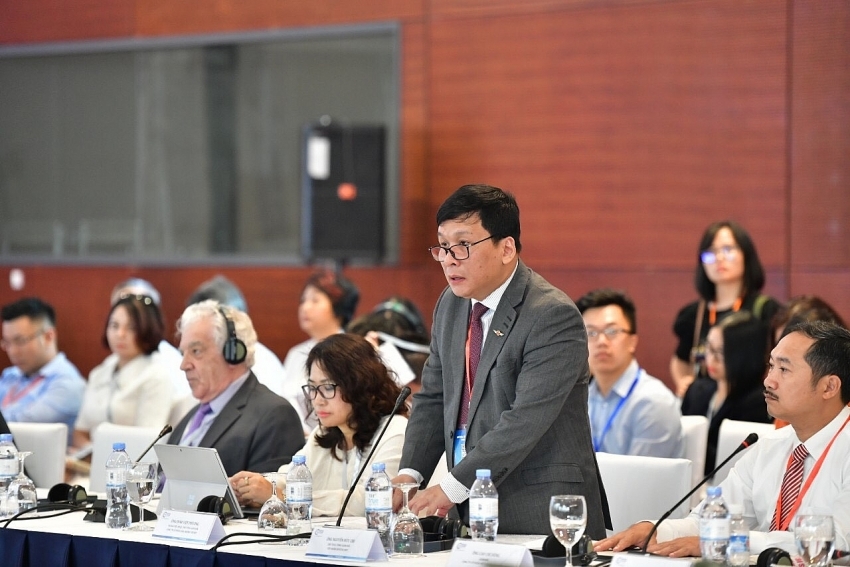Keys for Vietnam tourism to take-off
At the session of Vietnam Private Sector Economic Forum on providing tips on accelerating the development of the local tourism sector, experts have stressed the importance of having in place breakthrough policies on visa provision.

The session on accelerating the development of the local tourism sector, which took place in the framework of Vietnam Private Sector Economic Forum 2019
According to Luong Hoai Nam, deputy general director of Viet Star JSC and member of the Tourism Advisory Council, visa is crucial in tourism development and receives foremost attention in tourism policies of countries around the world.
Addressing the session, Dinh Viet Phuong, deputy CEO of fledging budget carrier Vietjet, reported that the number of the company’s international routes is even higher than its domestic routes and that swifter and smoother visa proceedings, particularly e-visa, is always one of the top issues for investors.
Phuong cited the example of South Korea, which offers a five-year visa to residents living in Vietnam’s three major cities (Hanoi, Ho Chi Minh City, and Danang), while Vietnam also provides visa exemption scheme to Koreans.
This mutual easing of visa policies brought a 45 per cent jump in the number of Korean passengers on Vietjet’s flights and an abrupt increase in the number of Vietnamese people going to South Korea.
“Korea’s soft visa policy and visa exemption to frequent travellers (three times a year) have resulted in a sharp growth in the number of visitors to both countries,” Phuong commented.
“Our passenger volume is on a steady rise. Due to the big volume of passengers at the airports, it is important to reduce the travelling time. Albeit airports are fairly quick in completing procedures, it still takes time for the passengers to receive their luggage," Phuong added. “We, therefore, suggest airport authorities and customs bodies to apply measures to shorten the time the passengers are given their luggage."
Customs officers at local international airports such as Danang, Cam Ranh, and Phu Quoc are in a critical shortage.
Airport infrastructure improvements are essential
The current airport infrastructure cannot follow the aviation sector’s robust development. As of March 2019, Vietnam was home to 22 airports, including nine international airports.
During 2014-2018, Vietnam has been named among countries with the fastest-growing aviation industry, together with China and India. This came in the wake of the country’s open-door policy and the engagement of the private sector.
During 2014-2018, Vietnam has been named among countries with the fastest-growing aviation industry, together with China and India. This came in the wake of the country’s open-door policy and the engagement of the private sector.
Since 2014, the passenger volume jumped 103 per cent, surpassing 100 million arrivals, growing at an average of 20.5 per cent annually.
Phuong from Vietjet assumed that as 99 per cent of travel firms are from the private sector, if the state cannot finance infrastructure investments, the private sector must be given more room to take over. Private investors have the capacity to construct a new terminal in 12-18 months.
Phuong underlined the need to have a comprehensive assessment of airport planning to tackle the current overload experienced across the country.
In fact, major international airports are facing the largest problems. Tan Son Nhat, Danang, and Cam Ranh are overloaded, whereas Noi Bai, Cat Bi, and Phu Quoc are reaching their full designed capacity and are forecast to face frequent overloads in the coming time, even though they have added new infrastructure in the past years.
One example is Cam Ranh international terminal which has a designed capacity of 2.5 million passengers per year. After six months in operation, the terminal has welcomed three million passengers, which would make it necessary to double its capacity.
Ineffective forecasting has led to ill-conceived airport development strategies, allowing most airports to reach their full capacity in a year or two after being put into commercial operations.
Due attention must also be paid to delays in implementation and high investment costs.
Let’s have a look at regional countries. With 70 million residents, Thailand received 38 million visitors last year at its 52 airports. Singapore, with six million residents, welcomed 18 million visitors (triple its population) through a single airport that has the capacity to receive 66 million passengers. This proves that the growth of the tourism sector must be accompanied by parallel investment into airport infrastructure development.
In this context, the Vietjet representative has recommended stimulating private sector participation in airport infrastructure development, alongside a raft of measures, including reviewing the planning and actual construction process of airports, attracting partial or whole private sector engagement into airport projects, perfecting the regulatory system to create an equal playing field among businesses and working out a long-term development plan for the airport system.
Dinh Viet Thang, head of the Civil Aviation Authority of Vietnam, praised the role Vietjet plays in the development of the local aviation industry, saying that the carrier's presence was creating a turnaround in the domestic aviation landscape.
Thang raised several limitations hampering aviation business, including infrastructure and lack of synchronised measures to ensure the sector’s safe and sustainable development.
“A complete legal framework must be in place to encourage the private sector's engagement in airport infrastructure development. In addition, hiring foreign consultants to work on airport development planning is also important to meet objectivity and long-term goals,” Thang said.
VNN
 Community tourism transforms livelihoods in remote areas
Community tourism transforms livelihoods in remote areas
 Agoda lists Da Lat among cheapest destinations for year-end holidays
Agoda lists Da Lat among cheapest destinations for year-end holidays
 TasteAtlas picks out two Vietnamese dishes among world’s 100 best rated crustacean dishes
TasteAtlas picks out two Vietnamese dishes among world’s 100 best rated crustacean dishes
 Vietravel expands business in Indian market
Vietravel expands business in Indian market
 2025 Nha Trang – Khanh Hoa Sea Festival to spotlight cultural heritage space
2025 Nha Trang – Khanh Hoa Sea Festival to spotlight cultural heritage space
Vietnam, a unique destination attracting Indian tourists: Indian newspaper
 Cao Bang eyes new opportunities for cross-border tourism development
Cao Bang eyes new opportunities for cross-border tourism development
 Kien Giang strives to attract tourists to finish the year on high note
Kien Giang strives to attract tourists to finish the year on high note
 Rivers provide major resources to boost Vietnam’s tourism
Rivers provide major resources to boost Vietnam’s tourism
 Dong Thap plants over 100 ha of flowers for Tet
Dong Thap plants over 100 ha of flowers for Tet



